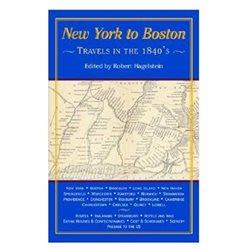First hand accounts of history are windows into the past. Imagine what it must have been like to live and travel in the northeastern corridor of the United States during the nation's formative years in the 1840's. Here are selections from two works written only four years apart during that decade, Dickens' American Notes and D. Appleton & Co.'s The American Guide Book. The juxtaposition of the Guide's observations to those of Dickens is a case of the whole being greater than the sum of its parts. The self-professed objective of the Guide's editors: "comprehensiveness with brevity being essential qualities for a work of this kind, all extraneous matter has been omitted, and it is hoped the work will be found to consist of all that is likely to be useful or interesting to travelers." Dickens is one of those travelers, but his coverage of the same areas is more idiosyncratic, and frequently observed with a comic eye unique to Dickens. What emerges between the two is a fascinating portrait of a new, growing nation. According to the Guide, "If they continue united [the States] they will then become the greatest nation in the world; and the most powerful of the states of Europe would rank as secondary to them." Dickens makes more opinionated observations. On the one hand he can be highly complimentary of the American character: "They are, by nature, frank, brave, cordial, hospitable, and affectionate. Cultivation and refinement seem but to enhance their warmth of heart and ardent enthusiasm; and it is the possession of these latter qualities in a most remarkable degree, which renders an educated American one of the most endearing and most generous of friends." He has problems, however, with Americans as well, their cleanliness, their boorishness, the muckraking, "licentious" nature of their Press, and, in particular, the odious institution of Slavery. Ultimately, Dickens' trip
-
- Categories
- Other
- Australia
- China
- New Zealand
- United States
- United Kingdom
- France
- Spain
- Italy
- Turkey
- Germany
- Malaysia
- Mexico
- Austria
- Russia
- Ukraine
- Thailand
- Saudi Arabia
- Greece
- Canada
- Poland
- Netherlands
- Singapore
- Hong Kong
- Taiwan
- South Korea
- Japan
- Brazil
- Argentina
- Indonesia
- Vietnam
- India
- Morocco
- South Africa
- Tunisia
- Zimbabwe
- Algeria
- Kenya
- Egypt
- United Arab Emirates
- Syria
- Jordan
- Iran
- Israel
- Qatar
- Dominican Republic
- Chile
- Puerto Rico
- Peru
- Uruguay
- Costa Rica
- Mauritius
- Sweden
- Nepal
- New
- Popular
- Gifts
- Videos
- Help / Contact Us
- Terms & Privacy
- What is TripTerest


